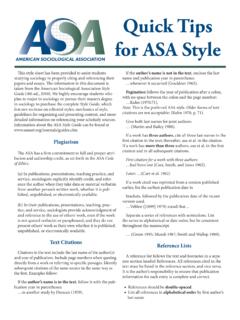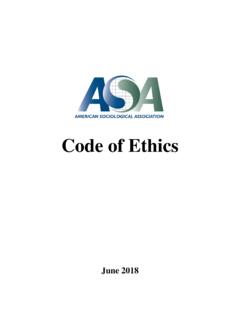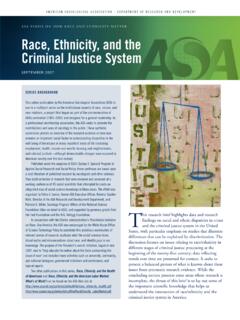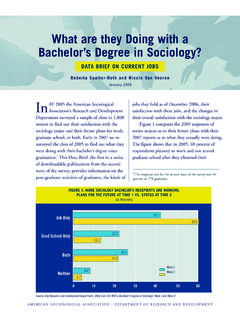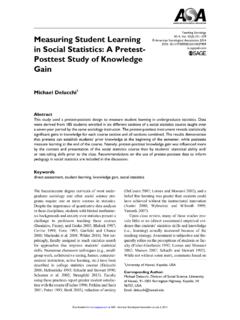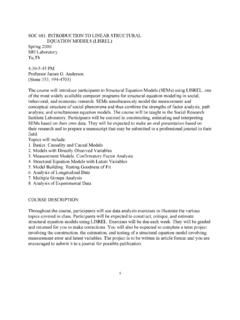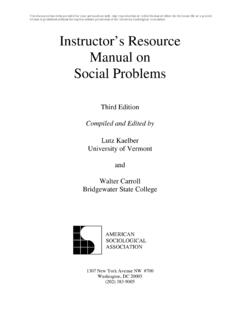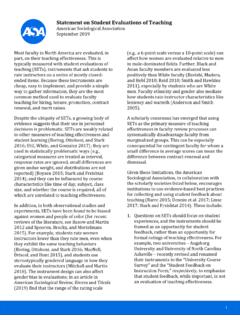Transcription of The Sociology of Gaslighting
1 Sociological Review2019, Vol. 84(5) 851 875 american Sociological association 2019 DOI: Cukor s 1944 film Gaslight1 tells the story of Paula (Ingrid Bergman) and her new husband Gregory (Charles Boyer), who sets about the task of isolating her and making her believe she is insane. His eponymous tactic is to dim and brighten the gaslights and then insist she is imagining it. Gregory aims to undermine Paula s sense of self and everyday life, to confuse and distort her reality such that she must accept his imposed reality in place of her , Gaslighting is an increasingly ubiqui-tous term used to describe the mind-manipulating strategies of abusive people, in both politics and interpersonal relationships. Dozens of online checklists instruct readers on the warn-ing signs of Gaslighting in their intimate rela-tionships. A second edition of Robin Stern s bestselling 2007 book The Gaslight Effect was released in 2018, and the new version considers how psychological manipulation dominates the post-truth political era.
2 The Guardian s Ariel Leve wrote an article in 2017 titled, Trump is Gaslighting America. Psychotherapist Steph-anie Sarkis, whose popular book Gaslighting came out in 2018, makes a similar argument. Gaslighting was even made an official part of criminal domestic violence law in the United Kingdom in 2015, and more than 300 people have since been charged with the offense (Mikhailova 2018).Despite its growing recognition as an abu-sive power tactic, sociologists have ignored Sociological ReviewSweetresearch-article2019aHarvard UniversityCorresponding Author:Paige L. Sweet, Harvard University, 1730 Cambridge Street, CGIS S410, Cambridge, MA 02138 Email: Sociology of GaslightingPaige L. SweetaAbstractGaslighting a type of psychological abuse aimed at making victims seem or feel crazy, creating a surreal interpersonal environment has captured public attention.
3 Despite the popularity of the term, sociologists have ignored Gaslighting , leaving it to be theorized by psychologists. However, this article argues that Gaslighting is primarily a sociological rather than a psychological phenomenon. Gaslighting should be understood as rooted in social inequalities, including gender, and executed in power-laden intimate relationships. The theory developed here argues that Gaslighting is consequential when perpetrators mobilize gender-based stereotypes and structural and institutional inequalities against victims to manipulate their realities. Using domestic violence as a strategic case study to identify the mechanisms via which Gaslighting operates, I reveal how abusers mobilize gendered stereotypes; structural vulnerabilities related to race, nationality, and sexuality; and institutional inequalities against victims to erode their realities. These tactics are gendered in that they rely on the association of femininity with irrationality.
4 Gaslighting offers an opportunity for sociologists to theorize under-recognized, gendered forms of power and their mobilization in interpersonal , domestic violence, gender, sexuality, intersectionality852 american Sociological Review 84(5) Gaslighting , leaving it for psychologists to study. This, I argue, is a mistake. Gaslighting is fundamentally a social phenomenon. Engag-ing in abusive mental manipulation certainly involves psychological dynamics, but scholars have thus far disregarded the social character-istics that actually give Gaslighting its power. Specifically, Gaslighting is effective when it is rooted in social inequalities, especially gender and sexuality, and executed in power-laden intimate relationships. When perpetrators mobilize gender-based stereotypes, structural inequalities, and institutional vulnerabilities against victims with whom they are in an inti-mate relationship, Gaslighting becomes not only effective, but article develops a sociological theory of Gaslighting using in-depth analysis of life story interviews with women attending domestic violence support groups.
5 I define Gaslighting as a set of attempts to create a surreal (Ferraro 2006) social environment by making the other in an intimate relation-ship seem or feel crazy. I argue that gas- lighting tactics become consequential when abusers mobilize macro-level inequalities related to gender, sexuality, race, nationality, and class against an intimate other. By conse-quential, I mean that such tactics damage victims sense of reality, autonomy, mobility, identity, and social psychological approaches to gas- lighting , a sociological theory of Gaslighting must show how macro-level social inequali-ties are transformed into micro-level strate-gies of abuse. Decades of research reveal that no form of abuse can be extracted from social context: anyone can use manipulative tactics against anyone else, but such actions only transform victims lives becoming abusive (Stark 2010) when they are embedded in relations of power.
6 The theoretical framework offered here has two , Gaslighting works when deployed in power-unequal intimate relationships, creating an environment of surreality. Second, gas- lighting works when perpetrators mobilize gender-based stereotypes, intersecting inequali-ties, and institutional vulnerabilities against victims. This second point is critical because women do not typically have the cultural, eco-nomic, and political capital necessary to gas-light men Gaslighting is therefore a gendered phenomenon. In fact, whether or not it is exer-cised by a male-bodied person against a female-bodied person, Gaslighting tactics construct victims in terms of feminized survey data suggest that gaslight-ing is common in domestic violence situa-tions, preventing women from accessing resources (Warshaw et al. 2014). As my anal-ysis shows, Gaslighting can amplify the dan-gers already present in abused women s lives.
7 Gaslighting can also prevent domestic vio-lence victims from accessing institutional resources that would help them escape the abuse. Indeed, the very institutions set up to help victims can become part of the gaslight-ing process. Gaslighting should be of interest to sociologists, then, because domestic vio-lence is widespread and Gaslighting is a core feature of intimate , the importance of Gaslighting for soci-ologists extends well beyond the case of domestic violence: first, Gaslighting occurs in other types of interpersonal relationships, cre-ating and exacerbating power imbalances; second, accepting purely psychological approaches to Gaslighting risks the prolifera-tion of context-free analyses; and finally, gas- lighting exposes how the association of women with irrationality exacerbates existing gender and sexual inequalities. A theory of Gaslighting therefore offers an opportunity for sociologists to identify and analyze under-recognized, gendered forms of power and their mobilization in interpersonal relation-ships across a range of A SoCioLoGiCAL Theory of GASLiGhTinGPsychological Accounts of GaslightingDespite the recent journalistic use of gaslight-ing to name Trump s political strategy, gas- lighting is traditionally understood as an interpersonal, psychological dynamic.
8 In fact, psychotherapists popularized the term. Sweet 853 Barton and Whitehead are thought to have coined Gaslighting in a 1969 Lancet paper that analyzed involuntary hospitalization as a form of The term then appeared a handful of times in the psychotherapeutic lit-erature during the 1970s and 1980s (Calef and Weinshel 1981; Gass and Nichols 1988; Smith and Sinanan 1972). However, gas- lighting seems to have fallen out of use until psychotherapist Robin Stern popularized it in her 2007 book, which holds that Gaslighting is a phenomenon of mutual participation between gaslighter (perpetrator) and gas-lightee (victim). She writes, The first step is to become aware of your own role in gaslight-ing, the ways in which your own behavior, desires, and fantasies may be leading you to idealize your gaslighter and seek his approval (Stern [2007] 2018:xxvii).
9 Although Stern claims that Gaslighting is gender-neutral, nearly all her case studies involve a heterosexual male partner as gas-lighter and a woman as gaslightee. Stern places responsibility on the gaslightee to fix or get out of the relationship. Psychologi-cal uses of Gaslighting like Stern s highlight the importance of intimate relationships in Gaslighting , but they ignore the gender-based structural conditions that make Gaslighting possible, and they fail to locate Gaslighting as a common feature of domestic Literature and Allusions to GaslightingIn contrast, the intimate partner violence (IPV) literature does not regularly use the term gas- lighting , yet it offers extensive evidence that Gaslighting is gendered and is common in abusive relationships. Gaslighting emerges as a sense of surreality, confusion, and distor-tion systematically experienced by victims.
10 For example, Ferraro (2006:73) describes what she calls surreality, showing how abusers spin tales that violate victims sense of reality, distorting their perceptions of every-thing from minor details of everyday life to their partners entire biographies. Williamson (2010:1418) describes domestic violence as unreality, because abusers consistently attempt to determine the boundaries of vic-tims realities. Johnson (2008:9) writes, It s her crazy behavior .. that requires him to control her .. she s [really] the abusive part-ner. She s so out of touch with reality that maybe she should get some help. Dobash and Dobash s (1979:105) landmark study refer-ences abusers consistent construction of women as exaggerating and making up the violence; abusers in their study even invented tales of wives infidelities and tried to con-vince their wives the stories were true.
